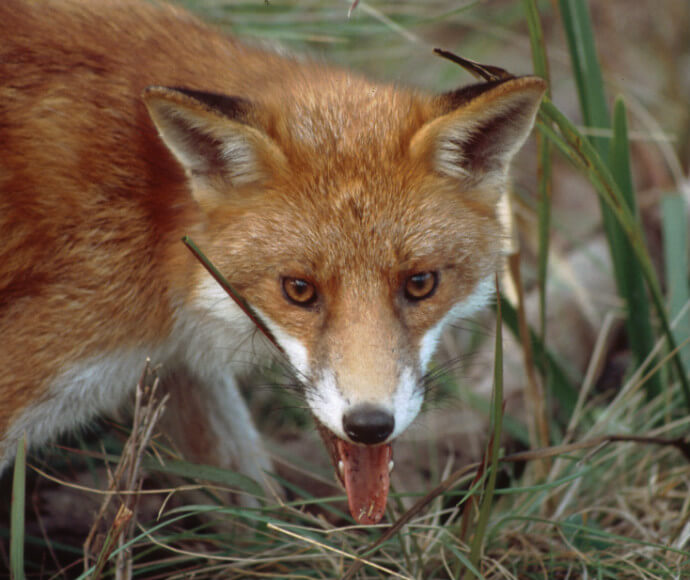Invasive, introduced pest animals and weeds are widespread across New South Wales. Many are listed as key threatening processes and pose a danger to over 70% of all threatened species.
The New South Wales Invasive Species Plan 2023–2028 sets out goals, strategies and guidelines to exclude, eradicate or manage invasive species across all lands in New South Wales.
NPWS has developed specific regional pest management strategies for the control of pest animals and plants within the NSW national parks estate.
Pest animals and weeds found in our national parks
Pest animals like foxes, wild dogs, feral pigs, rabbits, feral goats and feral cats are widespread across the state. Other pests, such as feral horses, deer, rats and cane toads, present localised problems in some parks and reserves.

Fox, introduced species, pest and threat to native animals
Invasive weeds can include bitou bush, lantana, blackberry, scotch broom, African olive, introduced perennial grasses, such as Coolatai and buffel grass, and exotic vines and scramblers, such as asparagus weeds. All of these weeds are listed as key threatening processes in New South Wales.
Currently, one of the most important weed programs in New South Wales is the eradication of 2 new species, orange hawkweed and mouse-ear hawkweed, from Kosciuszko National Park.
What damage do they do?
Since the arrival of Europeans, there have been significant declines and extinctions among Australia’s native animals and plants. Introduced pest animals and weeds have been identified as the major cause for many of these losses.
Pests continue to represent one of the greatest threats to biodiversity in Australia with new species still being detected. They also cause financial losses to agriculture and other industries and damage areas of cultural significance.
Managing the impacts of pests is an issue of great importance for managers of all land tenures. The issue requires sustained, integrated, long-term management to minimise damage to environmental, economic and social values.
How did they get here?
Australia's introduced plants and animals date from the very first days of European settlement in the late 1700s. Ever since, they have been brought from other countries and released into the Australian environment.
Introduced weed species are exotic plants that have formed naturalised populations. Most have been introduced as garden plants, pasture grasses or other horticultural plants.
Pest animal populations include feral goats, deer and pigs and are descended from domesticated herds imported for agriculture. Feral cats and dogs, which may have escaped from their owners or been intentionally dumped in the bush, pose a significant threat to native species and farming interests.
When national parks are created, pest animals and weeds may already be well established.
Pest animal management
Pest animals in New South Wales are managed by the following organisations:
- NSW Department of Primary Industries and Regional Development
- Local Land Services
- Environment Protection Authority
- Department of Climate Change, Energy, the Environment and Water – National Parks and Wildlife Service (NPWS)
- private land managers, communities and special interest groups
- local government
- industry.
NPWS is responsible for managing national parks and nature reserves for the protection and conservation of biodiversity in New South Wales.
We manage pests within the state's park system to protect native animals and plants, maintain natural ecosystems and cultural heritage, and minimise the spread of pest animals and weeds to and from neighbouring land.
The complete eradication of pests over wide areas of different land tenure is rarely practicable. It is therefore necessary to prioritise pest management efforts and allocate resources to those areas where they will be of greatest benefit.
Priorities include:
- areas where new pest outbreaks occur
- where threatened native plants and animals are at risk from the impacts of pests
- where there is a need to minimise the impacts of pests on neighbouring lands, such as farmland
- where pests impact significantly on human health
- where pests impact significantly on heritage areas.
NPWS works with other government agencies, Catchment Management Authorities, private landholders and community groups to protect native species, the environment and agriculture on neighbouring lands.
Pest animal management programs and priorities
Managing pest animals in our national parks involves:
- developing and implementing regional pest management strategies
- developing and implementing threat abatement plans for specific animals
- native species recovery programs
- research to ensure the protection of threatened species
- community education.
Current pest management priorities for NPWS are detailed in the regional pest management strategies. Furthermore, the NSW Saving our Species (SOS) program provides priorities for the protection of threatened species from pests and weeds (and other threats) across New South Wales.
Weed management
NPWS carries out weed control programs across New South Wales. We identify and prioritise specific sites where control programs will be of most benefit to native biodiversity. The NSW Saving our Species (SOS) program provides priorities for the protection of threatened species from pests and weeds (and other threats) across New South Wales.
Read more about our weed management, strategy and priorities.